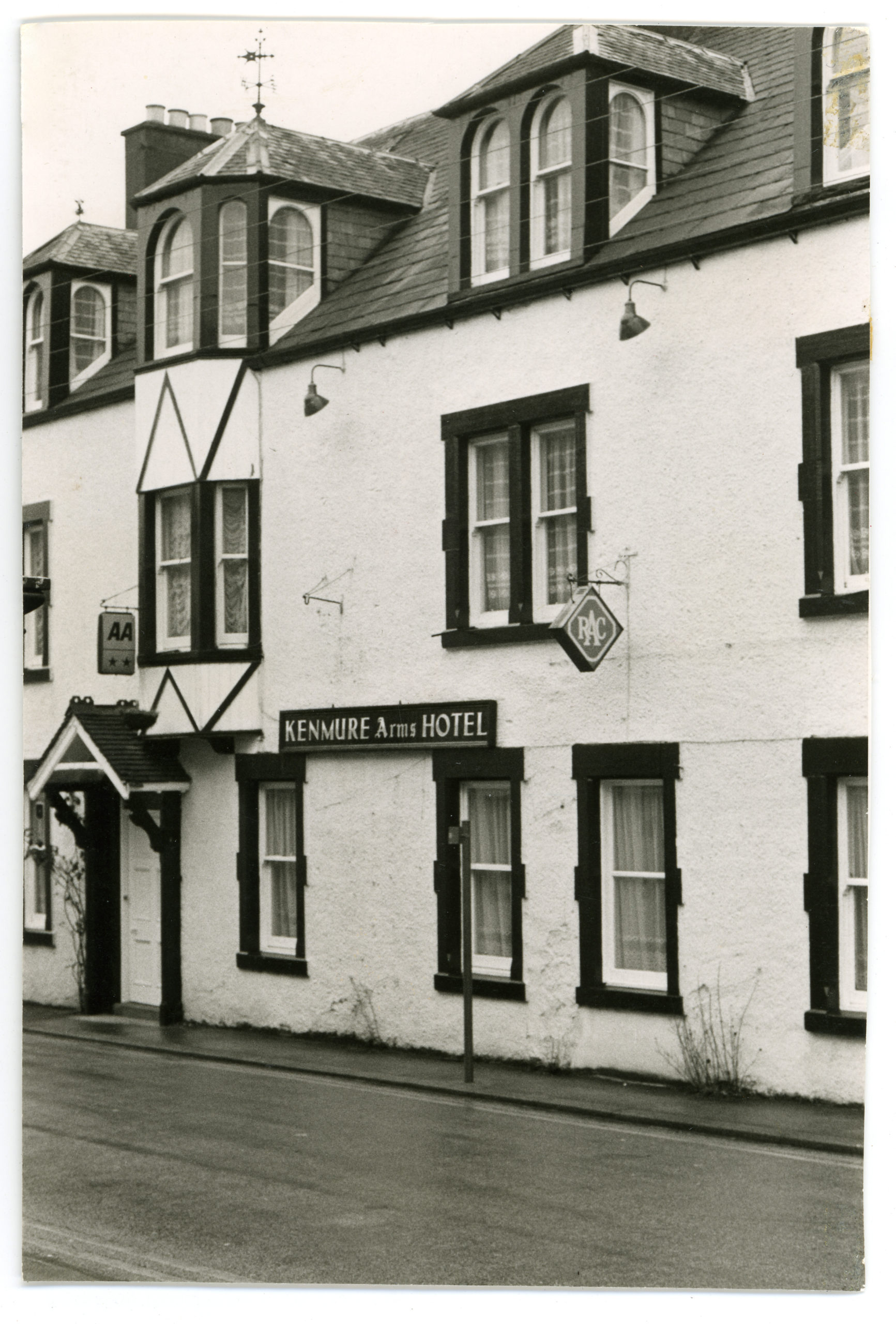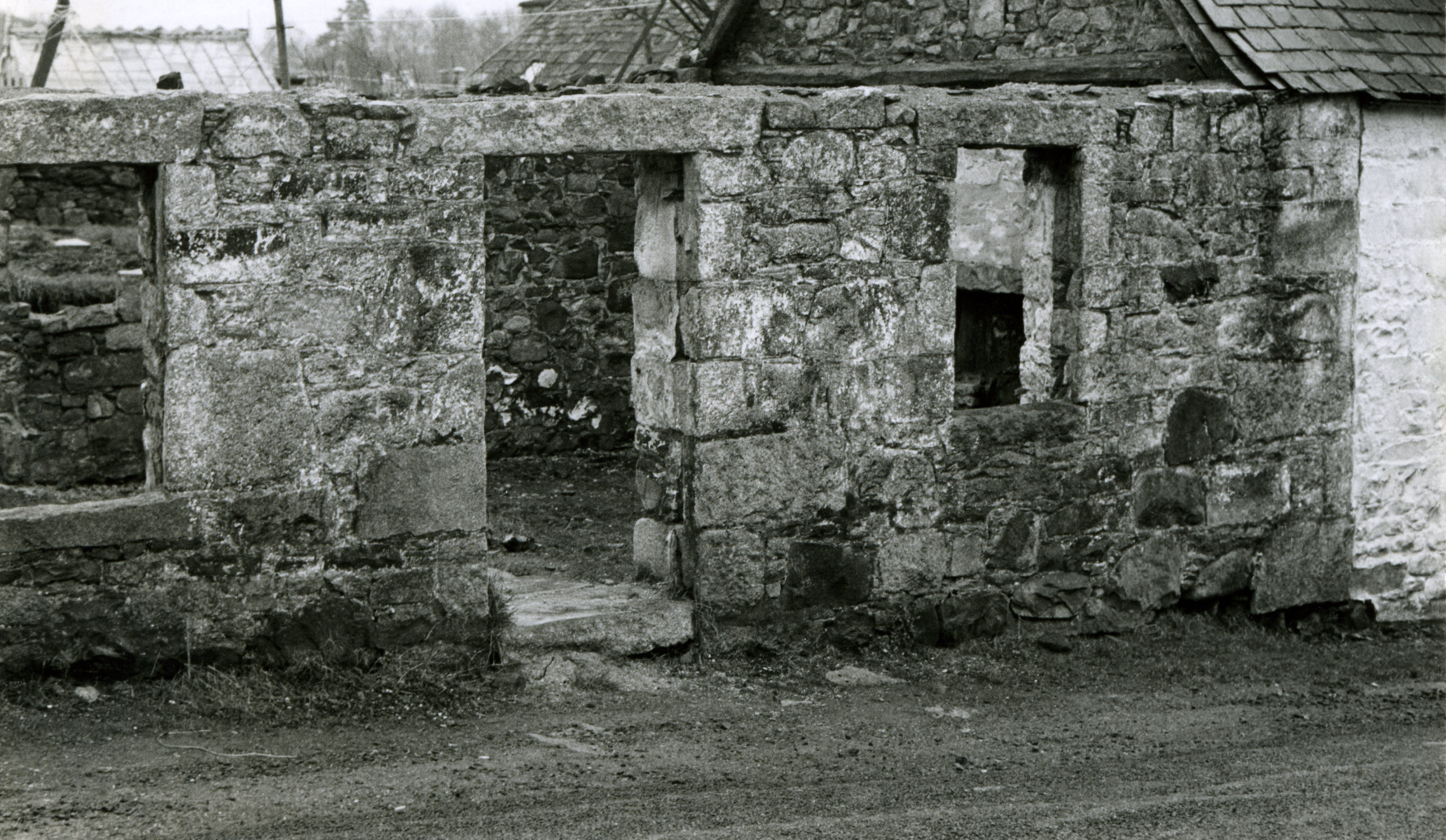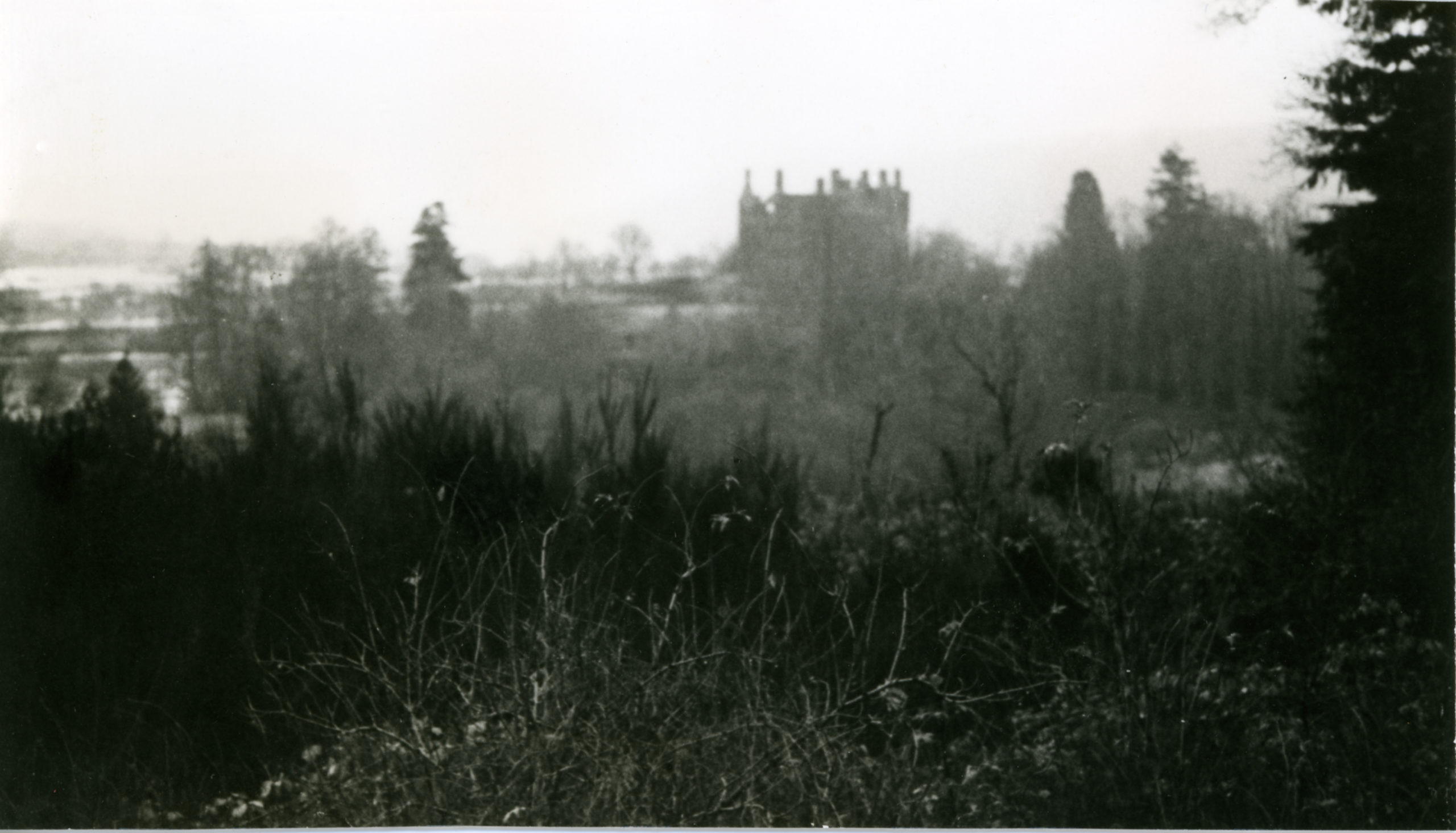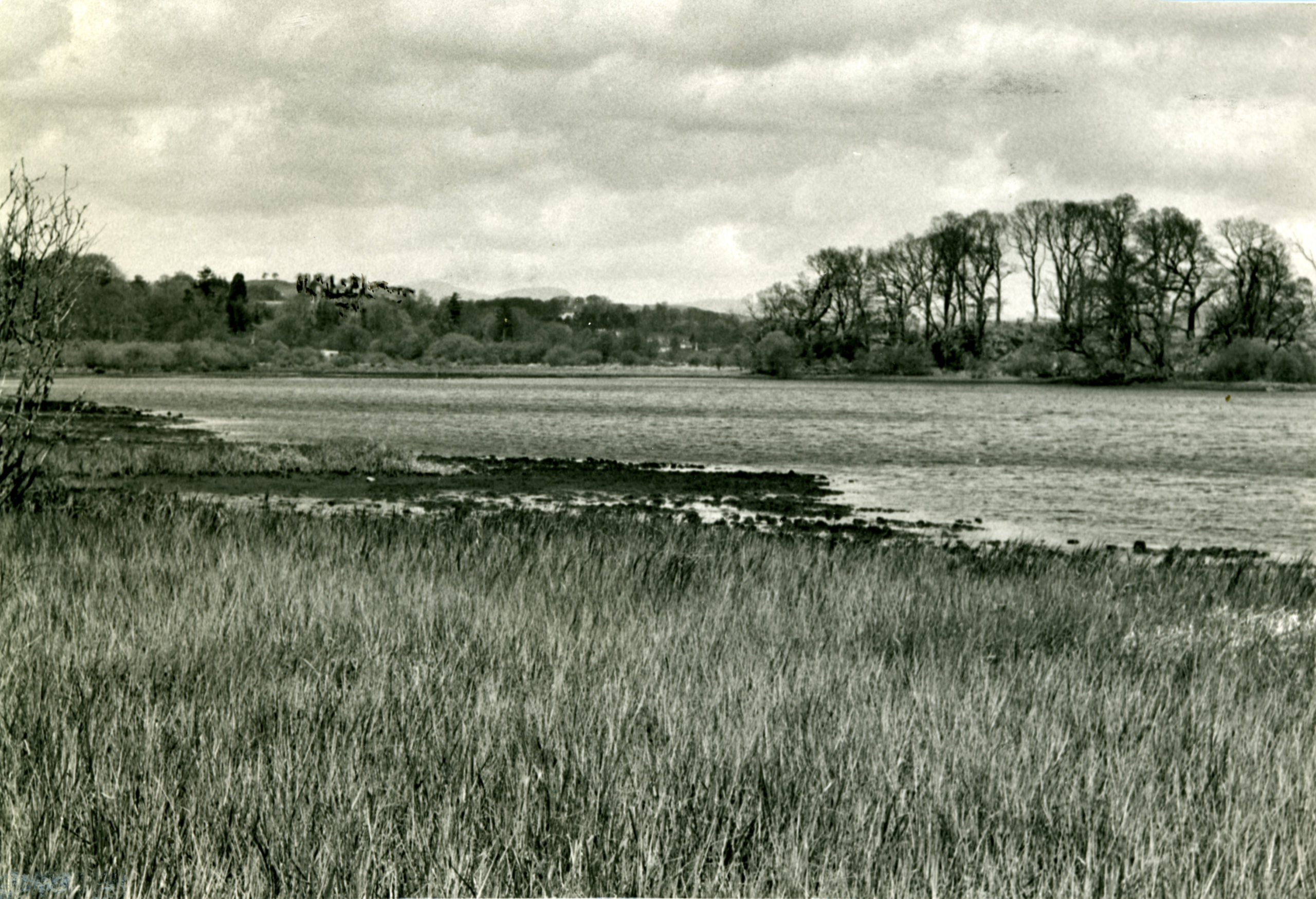By Frederick Buller
Most middle-aged anglers have witnessed an enormous growth of interest in fly fishing for fish other than traditional prey: the trout in all its forms and the lordly salmon. This development makes a fish of any species, freshwater or saltwater, a potential target if it can be taken on a fly or a fly-type lure. In all probability, fly fishing for pike has been practiced in Britain and elsewhere for centuries, but it has only recently, in the last twenty years or so, graduated into a major branch of the sport. As an example, to show just how far that development has progressed, let me advise American readers that nowadays the preferred method of removing unwanted pike from trout water in southern England—even from our famous chalk streams—is by catching them on 5- or 6-inch pike flies, a method followed by a growing band of enthusiasts. At this time, it may be appropriate to look back at Britain’s most-famous-ever fly-caught pike.
Members of the American Museum of Fly Fishing may remember seeing the engraving in Figure 1 in the Winter 2003 journal (vol. 29, no. 1), where it helped to illustrate my piece “Fly Fishing for Pike in Britain and Ireland.” In my book, The Domesday Book of Mammoth Pike (London: Stanley Paul, 1979), I related what I had discovered concerning the capture of what purported to be the largest pike (or freshwater fish of any kind) ever caught on a fly. I include that extended excerpt (pages 253–60 of the book) here.
John Murray’s Pike: Report from 1979
To the Editors of the Sporting Magazine:
Gentlemen:
As I have lately seen a pike, which weighed no less than the surprising weight of 72 lb., I have been induced to make a draught of the skeleton of the head, which I hope will merit a place in your Magazine as it cannot fail to be extremely interesting to the amateurs in fishing. I have also taken a draught of another animal of this kind which was caught this season and weighed 25 lb.
A scale is annexed by which the respective proportions of the two may be ascertained and which will convey some idea of the largest pike perhaps ever taken in Great Britain. There are no less than 22 rows of teeth in the under jaw.
It was caught in Loch Ken, near the small burgh of New Galloway, in Scotland, with nothing more than a common fly made of a peacock’s feather.
I am, Gentlemen,
Your most obedient humble servant
G.
June 4, 1798<sup>1</sup>
For pike fishermen, there is magic in the name of Loch Ken. And no wonder. The annals of pike fishing hold many inspiring references to the celebrated 72-lb. Kenmure Pike reputedly taken by John Murray, gamekeeper to Viscount Kenmure, on a 3½-inch “fly”’ (ca. 1774).
In 1968, having made an exhaustive study of this famous fish, I was prepared to accept that no trace of it remained and to consider the case closed. In October 1972, however, a friend, John Cranston, who had just returned from a deer-stalking trip in the Stewartry of Kircudbright, handed me a newspaper cutting, given to him by his stalker, Jack Henderson. The cutting referred to an article written about the Kenmure Pike by Malcolm Logan in a copy of the (now defunct) Country Life magazine, Angling, of January 1953.
Later at the British Museum, I located and read Logan’s account of his research. “Seized with consuming curiosity,” he had set out to find the missing skull of this giant pike, which, it seemed, had been kept in the library at Kenmure Castle until sometime after World War II.
Logan was a good detective. After a persistent and painstaking search, he found the remains of the pike head in a cottager’s outhouse somewhere in the locality of New Galloway. It now consisted of little more than a pair of enormous jawbones. To the upper jawbone two narrow fragments of the top of the skull were still attached. It was in bad condition: “The lower jaw was roughly nailed to the base of this case, on which some fragments of disconnected bone were scattered; and the wiring which held the upper and lower jaws together had rusted through and broken.”2 It can be readily understood that even in 1952, the Kenmure Pike head must have looked like so much rubbish to any but a knowledgeable observer.
From Logan’s article I learned that John Murray, the gamekeeper who caught the pike, was buried in Kells churchyard a mile or two from Kenmure Castle. I photographed the gravestone, and for the reader’s benefit include the inscription:
in memory of john murray
who died at kenmore jan. 3rd 1777
aged 61 years and who for 46
years had been a faithful servant
to the family of kenmore.
erected by the honorable
capt. john gordon.
Logan had noted the bas-relief figures on the gravestone (a fishing rod, a gun, a hound, and a powder horn), but had mistaken (as had other writers) the figure of a pigeon for that of a partridge—unlike my friend, Peter Thomas, who spotted the white collar on its neck immediately. On the reverse side of Murray’s tombstone is engraved a poem. It was written by the Rev. John Gillespie, minister of the parish at Kells, who had won a guinea offered (presumably by John Gordon, younger son of Viscount Kenmure) for the most suitable epitaph.
Ah John what changes since I saw
thee last;
Thy fishing and thy shooting days
are past.
Bagpipes and hautboys thou canst
sound no more;
Thy nods, grimaces, winks and pranks
are o’er.
Thy harmless, queerish incoherent talk,
Thy wild vivacity and trudging walk
Will soon be quite forgot. Thy joys
on earth—
A snuff, a glass, riddles and noisy
mirth—
Are vanished all. Yet, blest I hope
thou art,
For in thy station, well thou play’dst
thy part.
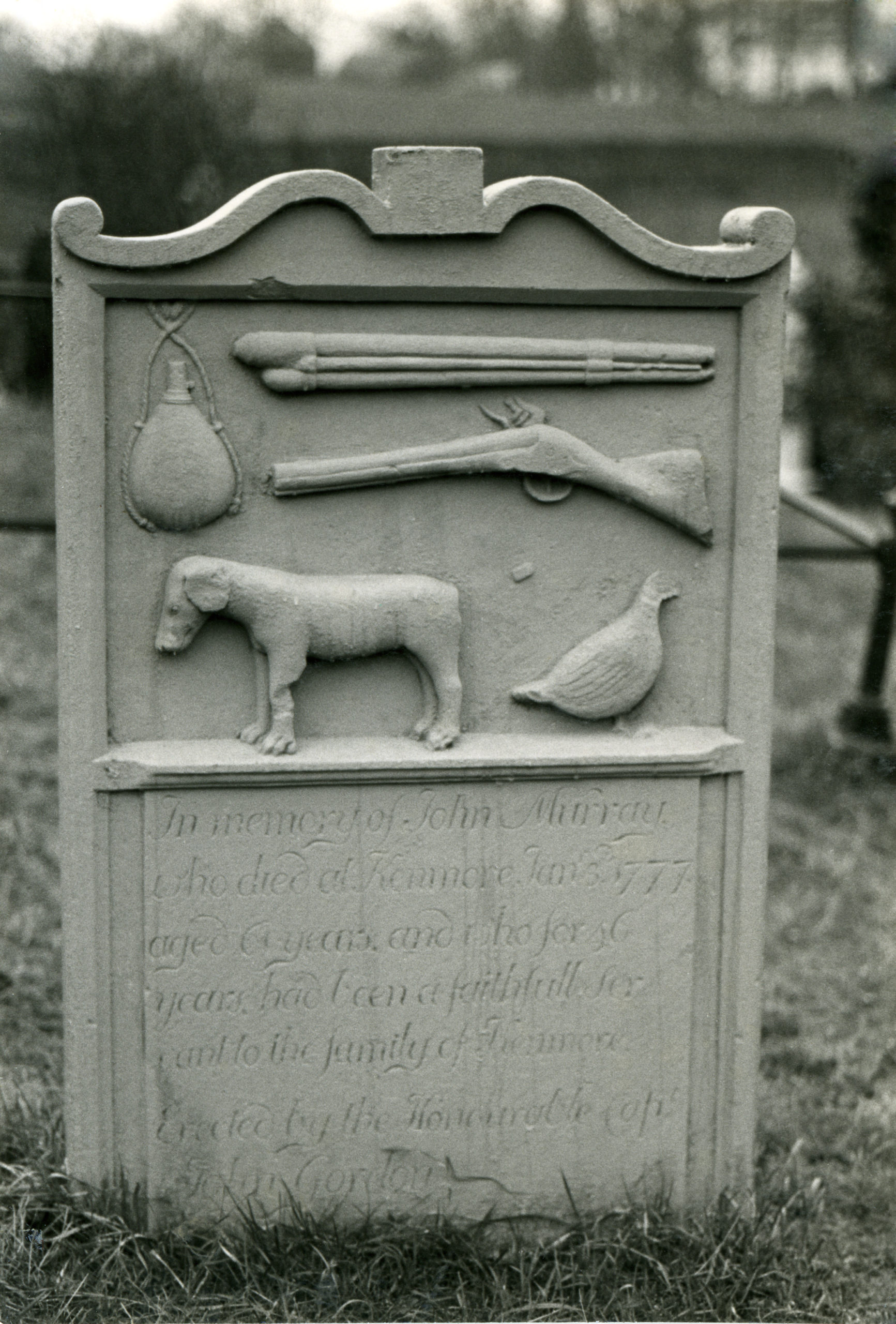
These verses give a wonderful insight into the character of this much-loved servant.3 Does not the line, “Thy nods, grimaces, winks and pranks are o’er” give a clue to the truth behind the legend that John Murray’s world-record pike was caught on a fly? And does not the following story recorded by Logan offer further evidence of Murray’s enterprising humor?
As keeper at Kenmure, Murray had the task of catching fish for the table; and after a long run of undersized trout had been forthcoming, his master remarked that the loch now contained nothing but parr. There was no doubt some warmth in Murray’s reply, when he threw down the great fish exclaiming, “Does your Lordship ca’ that a minnen [call that a minnow]?”4
One can imagine the question that Murray faced after his employer had recovered from the shock of seeing such an enormous fish; a fish so big that when Murray carried it back to the castle, the pike’s head was above his, while its tail trailed along the ground:
“I suppose you are going to tell me you caught it on a fly?”
“Why, of course my lord,” Murray would have said blandly.
On 15 January 1973, I again traveled north to New Galloway to make further inquiries among the 300 inhabitants of Scotland’s smallest royal borough. At lunchtime, with extraordinary luck, I ordered a dram of King’s Ransom whisky at the Cross Keys—an act that created an instant bond between myself and the licensee, Mrs. Davidson, whose late husband had loved this brand of whisky above all others.
She remembered that her husband had once possessed a photograph of a nineteenth-century painting of John Murray’s pike, and a subsequent search revealed a yellowing print. For those who would like to try their hand at dressing the fly that created one of the most enduring controversies in angling history, here are the details:
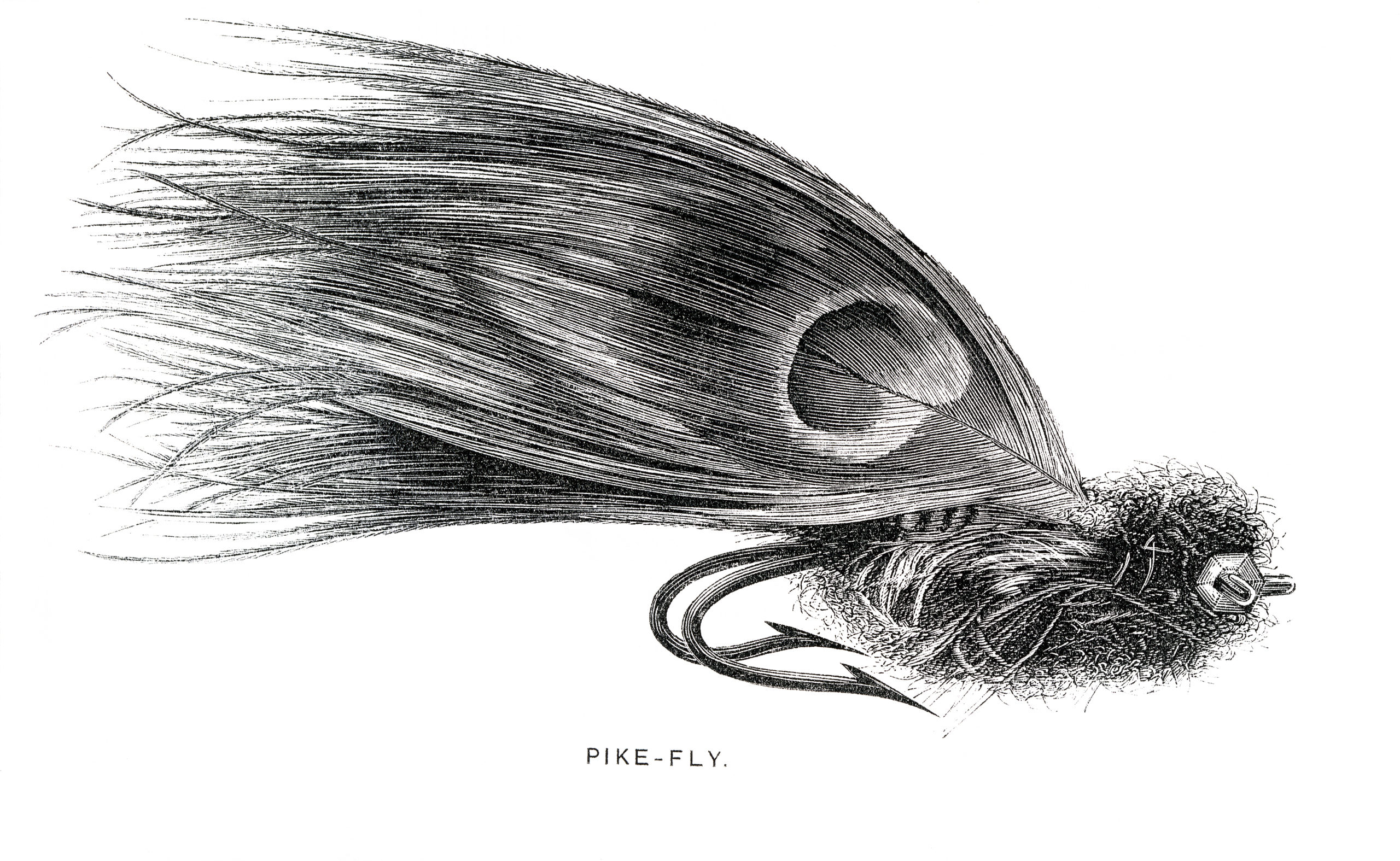
An engraving made from a drawing of the fly presented to
H. Cholmondeley-Pennell by Martin Kelly of Dublin. From H. Cholmondeley-Pennell, The Book of the Pike (London: Robert Hardwicke, 1865), 232.
The Fly which Caught the Kenmure Pike
3½ inches long
Black and red body
Blood cock hackles
Peacock and white turkey wings
Wild drake horns
Macaw tail
Dressed on cat gut
Wrapped in
copper wire.
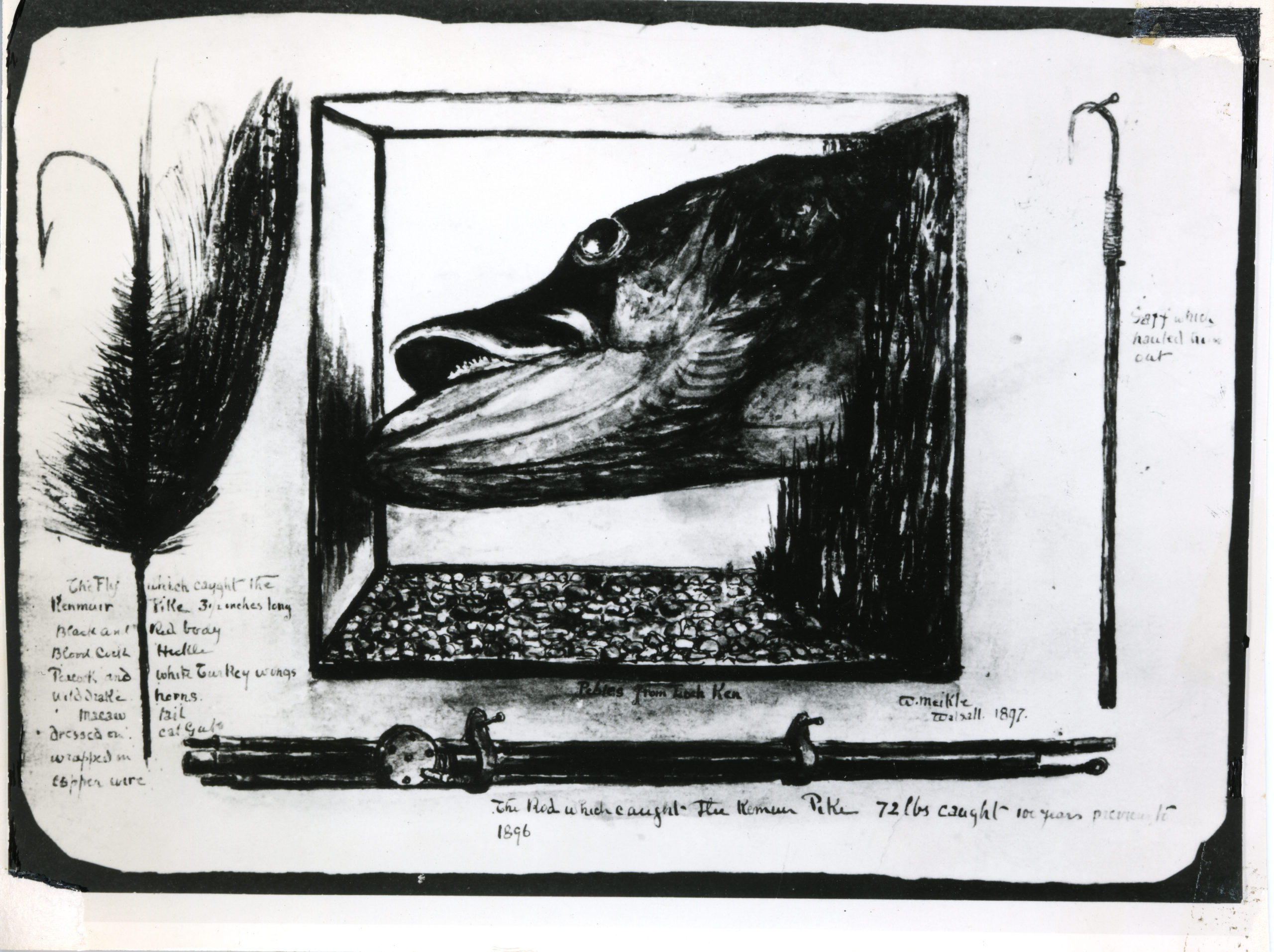
In 1897, W. Meikle, an expatriate Scot living in Walsall,5 painted a picture of the Kenmure Pike, the original of Mrs. Davidson’s yellowing print. A closer study of the painting shows that once a myth has been fabricated (in this instance, that the pike had been caught on a fly), it can be carefully embroidered with the sort of detail that fulfills the expectations of gullible people. In the painting, the pike’s head has eyes and a covering of skin—features that do not exist on an earlier engraving of the same head, published some ninety-five years before the painting was executed. Moreover, despite the lapse of 130 years since the pike’s capture, the painter managed to assemble not only the original fly but also all the rest of John Murray’s ancillary tackle—or rather, all that seemed appropriate to the taking of a pike with a fly. A supremely bogus touch is the artist’s inclusion of “pebbles from Loch Ken.”
Logan’s finding of the pike head in 1952 made me determined to find out if it still existed, especially in the light of his heartfelt plea: “Readers will, I think, share my hope as this famous relic was locked up once more in that outhouse, that this will not be the end of the story.”6
On 11 February 1973, I made yet another visit to New Galloway, and with kind help, I elicited details of the previous whereabouts and ultimate fate of the Kenmure Pike head. These are given in chronological order.
From a description given by Dr. Grierson, in an article that he wrote for the Annals of Philosophy for 1814, we know that the head of the Kenmure Pike was kept in the castle library. Toward the end of the nineteenth century (there being no surviving male heir), Kenmure Castle passed to another branch of the family: the Maitland Gordons. Despite this change of ownership, the head was still there when the famous British museum taxonomist Tate Regan took its measurements sometime between 1904 and 1917.
In 1924, after a wartime reversal in the family fortune, the castle was rented to General M. L. MacEwen. During his tenancy, according to his daughter, Miss M. W. MacEwen, the pike head was kept in the billiard room. A few years later, when General MacEwen bought the castle from the Maitland Gordon family, the pike head (being, as it were, a personal effect) was removed to Overton: a dower house in New Galloway, which still belonged to the Maitland Gordon family.
When John Maitland Gordon went abroad before World War II, he left the pike head in the safe keeping of Mrs. Douglas of the Kenmure Arms Hotel, New Galloway (Figure 3), who put the famous relic on view in the public bar.
About the year 1950, Michael Gordon, brother of John Maitland Gordon, returned to New Galloway to start a building business, and the pike head was once again taken back to Overton. Later, when Overton was emptied before its sale, the head was removed to a small village outhouse (Figure 4).7 It is here (in the outhouse of Logan’s account) that the Kenmure pike head finally came to grief.
At this time, the outhouse (once the property of Viscount Kenmure) was looked after by Geordie Bell, a worker on the Kenmure estate. In time, Michael Gordon moved out of the district, but the pike head remained in the outhouse until shortly after the death of Geordie Bell in 1955.
The outhouse was cleaned out during the period 1956–1957, when Mrs. Bell lived in England, so that what remained of the pike head (just a little pile of powdering bones in a broken glass case) was thrown away. And now, by the removal of its roof, the last resting place of the Kenmure head—the little outhouse—has suffered the same fate as Kenmure Castle: it became derelict after its roof was removed to avoid local taxes.
I am sure that Malcolm Logan’s wish, “that this will not be the end of the story,” will be granted. Even though the head of the Kenmure Pike no longer exists, controversy will always surround this mighty fish. Recently I have found evidence (supporting my own opinion) that the pike was caught on a live duck, as well as counterevidence to the effect that it was caught on a spinner. For the reader’s interest (and confusion) I append the items.
From C. H. Dick’s Highways and Byways in Galloway and Carrick (1916)
Soon after this Murray saw some ducklings on the water disappearing one by one. He took a duck as a bait, and began to angle with a strong rope. The duck went under, the line was taut and quivering, and it was plain that there was something powerful at the other end. As Murray drew back from the edge, he saw a mighty pike lashing the placid surface of the loch. He landed and killed it and carried it on his back to the castle. As he did so its head was above his, and its tail was trailing on the ground.8
From H. Cholmondeley-Pennell’s The Book of
the Pike (1865)
The attempt to delineate a great fish, or the taking of him, must certainly exercise some mystifying influence upon the piscatorial mind, for we find even Stoddart, generally so accurate, when alluding to the celebrated Kenmure Pike, going out of his way to describe him as having been taken with the fly, whereas, from the account which I have in my possession, it is clear that he was captured by the spinning-bait . . .
. . . To the Hon. Mrs. Bellamy Gordon, of Kenmure Castle, my best acknowledgements are due for an interesting account of this gigantic Pike and its captor, written on the spot by the Rev. George Murray of Balmaclellan.9
From the Fishing Gazette
31 December 1898
The Kenmure Pike
Dear Sir, Will you kindly allow me to answer a query set forth by our most esteemed and old mutual friend “Dragnet”? Speaking of the celebrated Kenmure pike in last week’s Fishing Gazette, he asks: “Perhaps some angler more learned in big pike captures will answer the query as to how, when, and by whom this lovely fish was taken?” Would that poor old John Murray could answer for himself, but, alas! poor John died on Jan. 3, 1777, and lies in Kells churchyard . .
The following letter was written at Kenmure Castle Nov. 9, 1885:
Dear Sir,—I have much pleasure in giving all the information I can regarding the great pike that was caught by my grandfather’s gamekeeper towards the end of the last century. There is little doubt it weighed at least 72 lb., but cannot remember to have heard its length or girth; only that John Murray was a tall man, and when he took it to my grandfather its head was resting on his shoulder and its tail trailing on the ground. He threw it at his master’s feet and said, “Tak the next yersel,” meaning, of course, he might catch one like it if he could. The pike was caught by a fly made of peacock feathers. I have part of the head in a glass case, but in a mutilated condition. I am, yours faithfully,
Bellamy Louisa Gordon.
p.s.—Why I stated at least 72 lb. is that I believe the Scotch pound in those days weighed some ounces more than at present. My uncle, Lord Kenmure, gave me the above information; he died in 1840, aged ninety-one. I forgot to state the fish was caught in Loch Ken, Kirkcudbrightshire.11
This letter by Bellamy Louisa Gordon was copied from the Fishing Gazette in 1885 by the writer, who believes the original is still in the hands of R. B. Marston, Esq., to whom it was sent by the Honourable Mrs. Bellamy Gordon in the ninetieth year of her age. By the way, it is worthy of notice that when speaking of “pike” to a Scotchman, they should be called “gedd,” as witness the following.
“Ye Ken Wha,” an old correspondent to the Fishing Gazette, states when you sends oot invites to fush for pike you maunna ca’ them pike, they micht na like it. Their fins are in their native flood, an’ their name is “gedd” (twa “dees” mind). They’re a wee thoucht touchy and they have sharp teeth. Hielan bluid, ye ken! But try them wi’ the “toddie!” Aha, lads!
Trusting dear “Drag” will “ken noo!” with “Ken Wha”
—And yours truly,
Frank Gosden
Reading
p.s.—Mr. J. Kenna, another old correspondent, in his big “gedd” reminiscence, remarks: “We paid particular attention to this piece of water, where, it is said, the celebrated angler, John Murray, caught the big ‘gedd,’ which weighed 72 lb., and, be it observed, with the fly. I’ll warrant he wielded a real mountain ash with a vigorous arm to cast almost over a bay the Peacock Tail Fly, about as large as a swallow.” This almost corresponds with the editor of the Fishing Gazette’s remark, viz., “It was evidently a big Alexandra.”12
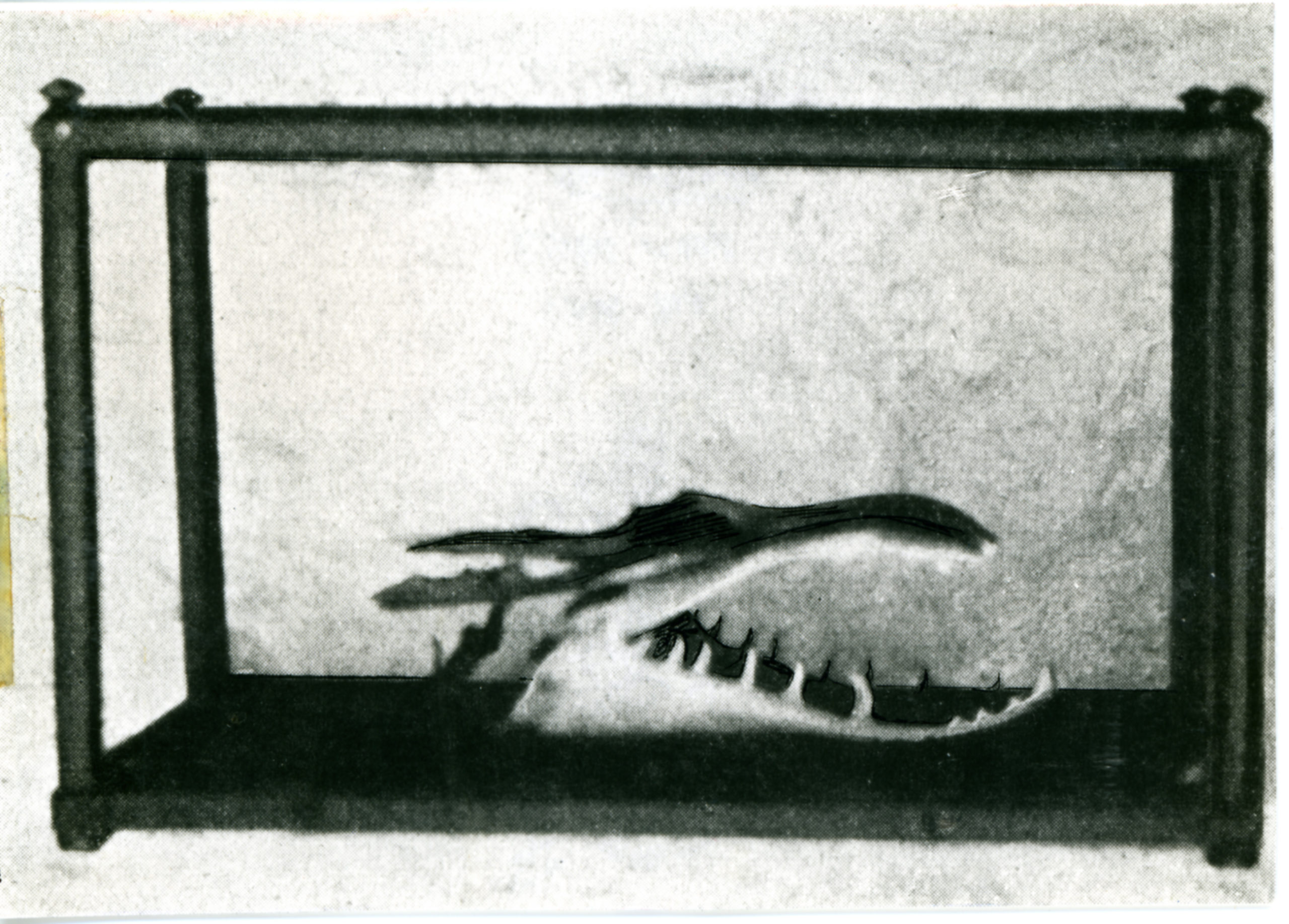
Malcolm Logan’s photograph of the encased Kenmure Pike skull. The original was first published in Angling. From Frederick Buller, The Domesday Book of Mammoth Pike (London: Stanley Paul, 1979), 255.
New Thoughts and Investigations: The Scottish Pound and the Loch Ken Pike
“He that knows nothing of numbers is scarcely a man.” So said Charles XII, King of Sweden.13
In 2006, while researching data for my book The Domesday Book of Giant Salmon,14 I ran into the same problem with regard to documenting a reliable weight for some large Scottish-caught fish taken during the latter part of the eighteenth century. These salmon ostensibly exceeded a weight of 60 pounds, but because of the problem brought to my attention by Bellamy Louisa Gordon in her statement, “I believe the Scottish pound in those days weighed some ounces more than at present,” I needed to take a closer look at the true value of the Scottish pound.
Avoirdupois weight (from the French, meaning to have weight) was brought into law in Britain in 1824 with the Weights and Measures Act, although in some areas in Scotland, variations persisted well into the 1840s. According to the book Weights and Measures in Scotland: A Modern European Perspective (Edinburgh: National Museums of Scotland, 2004), before this act, a chaotic system of weighing and measuring existed in Scotland, which authors R. D. Connor and A. D. C. Simpson set out to unravel.
Before the Weights and Measures Act, the Scottish pound (at least in Lanarkshire) was equivalent to 1 pound, 1 ounce, 8 drams of the imperial or English pound. This would lead us to believe that at the time of capture, Murray’s pike weighed 80½ imperial pounds, which seems to me to be most unlikely. My response was to set loose my friend David Hatwell, an indefatigable Internet detective, and he soon provided some information on the Scottish pound, or trone, via the online Scottish Archive Network’s Scottish Weights and Measures Guide. The value of the trone varied, according to district, from 21 ounces to 28 ounces avoirdupois. By taking 1 lb. = 28 oz. as the basis, we can calculate 72 x 28 = 2,016 oz. ÷ 16 = 126 lb. avoirdupois. While reeling from this result, I received a letter from David Devereux, the very helpful curator of the Stewartry Museum in Kirkcudbright (Kirkcudbright is only 11 miles from the southern end of Loch Ken) to whom I had written for help.
Regarding your enquiry about establishing the exact weight of the pike, and converting the 72 lb. quoted in 1774 into an Avoirdupois weight, I enclose a photocopy from The Lower Part of a New System of Practical Arithmetic by John Millar (1849). Page 96 has a useful list showing the various weights of the Scottish Pound Tron, expressed as Avoirdupois Ounces, used in different Scottish counties. You can see from this that the Pound Tron in the district of Kirkcudbrightshire between the rivers Urr and Fleet (in which area Loch Ken lies) was equivalent to 28 Ounces Avoirdupois. If it is assumed that the local weight measure was used, then, by my calculation, that would make the weight of the pike 126 lbs. Avoirdupois!15
The above calculations are undoubtedly correct, and confirm my own, but I still felt that another approach was required because a weight of 126 pounds for the Loch Ken pike is out of the question.16
Accordingly, I had another look at the first published account of Murray’s pike, which appeared in the Sporting Magazine or Monthly Calendar in July 1798. At the time, the publishers, Rogerson and Tuxford, claimed that theirs was the only magazine that catered to sportsmen, but more followed long before it ceased publication in 1871. Because it was published in London and doubtless catered principally to English sportsmen (albeit many of whom read it for the reports on cock fighting),17 I suggest that the pike’s weight in trones had already been converted to pounds avoirdupois before publication in order to be readily understood by its English readers. Furthermore, I feel that the bane of having varying values of the Scottish trone or pound is the reason Dr. Grierson reported a different weight for Murray’s pike in his book Mineralogical Observations in Galloway (1814).
In a footnote, he wrote about his own modest success with Loch Ken pike and then added, “But this is nothing in comparison of one that was caught by John Murray, gamekeeper to the Hon. John Gordon of Kenmore. It weighed 61 lbs., and the head of it is still preserved in Mr. John Gordon’s library at Kenmore Castle.”18 Where this gets me in proving the weight of Murray’s pike, I don’t know, but I am beginning to feel, as the king of Sweden said, “scarcely a man.”
Finally, I cannot resist reproducing one of the earliest known illustrations of a pike fly: an engraving made from a drawing of a fly presented to H. Cholmondeley-Pennell. It was published in Pennell’s The Book of the Pike, where he wrote, “The engraving is taken from a very fine specimen of the pike-fly as used in Ireland, and which was presented to me by Mr. Martin Kelly, of Dublin.”19
A Note and Postscript
While backtracking through my books and magazines in order to respond to questions asked by this journal’s editor, I have just discovered (5 April 2007) an entirely new (to me) line of enquiry regarding John Murray’s pike in a reference to the so-called Sibbald manuscripts. The reference was in a letter sent by James Robertson and published in Angling (March 1953, vol. xvi, no. 100). It would appear that the late John C. Hay, Robertson’s father-in-law, had sometime during the 1890s perused a manuscript “which claimed the Kenmure pike to be the largest freshwater fish caught in British waters and that it weighed 96 lbs.”
The manuscript, of which there are only two known copies, must be either eighteenth or nineteenth century in origin.
I look forward to making further investigations.
This article first appeared in the Spring 2008 (Vol. 34, No. 2) issue of the American Fly Fisher.
Endnotes:
1. Sporting Magazine (July 1798).
2. Malcolm Logan, “Tracing the Kenmure Skull,” Angling (January 1953, vol. xvi, no. 98), 12–16.
3. Transcription of the epitath originally appeared in the Rev. C. H. Dick’s Highways and Byways in Galloway and Carrick (London: Macmillan Press, 1916), 454.
4. Logan, “Tracing the Kenmure Skull,” 14.
5. Although a packman by trade, Meikle’s interests included archaeology, history, and photography. Angling (June 1951, vol. xiv, no. 79), 355.
6. Logan, “Tracing the Kenmure Skull,” 16.
7. There is some confusion as to when the head was removed to the outhouse. Horton Evans, writing in Angling (“Loch Ken Pike,” February 1951, vol. xiv, no. 75, 108), reported that when he stayed at the Ken Bridge Hotel some four years previously, in 1947, he was told that the head was kept in a nearby cottage.
8. Dick, Highways and Byways, 454.
9. H. Cholmondeley-Pennell, The Book of the Pike (London: Robert Hardwick, 1865), 14.
10. “J.B.,” writing in the Fishing Gazette of 2 January 1897, quotes the length of John Murray’s fish as being 7 feet.
11. Fishing Gazette (31 December 1898).
12. Frank Gosden, no reference available from original 1968 research.
13. Quoted in John Millar, A New System of Practical Arithmetic (Paisley, Scotland: Caldwell & Son, 1849), frontispiece.
14. London: Constable, 2007.
15. Letter to author, 4 October 2006.
16. C. Tate Regan’s closely argued support of the claimed weight of 72 pounds in his book Freshwater Fishes of the British Isles (London: Methuen & Co., Ltd., 1911) is compelling. Tate Regan, during his lifetime, became one of the most influential fish biologists of the British Museum (Natural History).
17. Important information during the heyday of gambling.
18. Dr. James Grierson, Mineralogical Observations in Galloway, published in The Annals of Philosophy (London: Baldwin, Cradock, and Joy, 1814), vol. 3, 420fn.
19. Cholmondeley-Pennell, The Book of the Pike, facing page 232.


